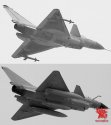The problem of long or wideband RF is that the pulse length has to be at least 1-1/2 times longer than the wavelength. So if you got long wavelength, you need even longer pulse.
That lowers your resolution.
So what pulse compression does is to take the long pulse, then using frequency modulation, add a spike in it to create a pulse within a pulse, like multiple small pulses within a long pulse. That improves the resolution against the subject.
That lowers your resolution.
So what pulse compression does is to take the long pulse, then using frequency modulation, add a spike in it to create a pulse within a pulse, like multiple small pulses within a long pulse. That improves the resolution against the subject.
Last edited:

